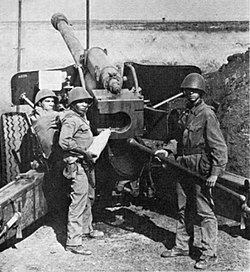
Cuban foreign policy during the Cold War emphasized providing direct military assistance to friendly governments and resistance movements worldwide. [1] This policy was justified directly by the Marxist concept of proletarian internationalism and was first articulated by Cuban leader Fidel Castro at the Organization of Solidarity with the People of Asia, Africa and Latin America in 1966. [2] However, as an informal policy it had been adopted as early as 1959, shortly after the Cuban Revolution. [2] It formed the basis for a number of Cuban military initiatives in Africa and Latin America, often carried out in direct conjunction with the Soviet Union and Warsaw Pact member states which provided advisory or logistical support. [3] These operations were often planned by the Cuban general staff through an overseas headquarters known as an internationalist mission. [1]
Contents
Military internationalism formed the crux of Cuba's foreign and military policy for almost three decades, and was subordinate only to domestic defense needs. [2] Its support for resistance movements in Central America contributed to Cuba's diplomatic isolation in that region and was instrumental in triggering its suspension from the Organization of American States. [2] Internationalist operations ranged from varying degrees of covert activity and espionage to the open commitment of combat troops on a large scale. [2] The Cuban military presence in Africa was especially notable, with up to 50,000 troops being deployed to Angola alone. [4]
Cuban forces in Africa were mainly black and mulatto. [5] Castro justified the use of the armed forces on the African continent as a result of the debt Cuba owed Africa due to its participation in the Atlantic slave trade and the contributions patriotic black Cubans had made to the Cuban War of Independence. [6] Internationalist missions were perceived by the Cuban government as one means of combating the global influence of the United States by proxy, and Cuba's opponents during these efforts were often decried as American proxies. [7] Likewise, the US government and its allies perceived the Cuban Revolutionary Armed Forces (FAR) as a Soviet proxy, and the use of internationalist missions as a means to indirectly increase Soviet military influence worldwide. [8] There were also more practical reasons for deploying Cuban troops abroad, such as giving the relatively inexperienced armed forces combat experience across a wide range of theaters. [6]
By the mid 1980s, a quarter of Cuba's total military strength was committed to its internationalist missions, fighting with socialist governments or factions in various civil conflicts. [8] At least 200,000 Cuban citizens had served overseas with the FAR in a number of capacities. [6] Military internationalism ended with the dissolution of the Soviet Union in 1991, which curtailed much-needed Soviet logistical and financial support needed to sustain Cuba's foreign expeditions. [6] The FAR terminated all its major overseas commitments between September 1989 and May 1991. [9]

